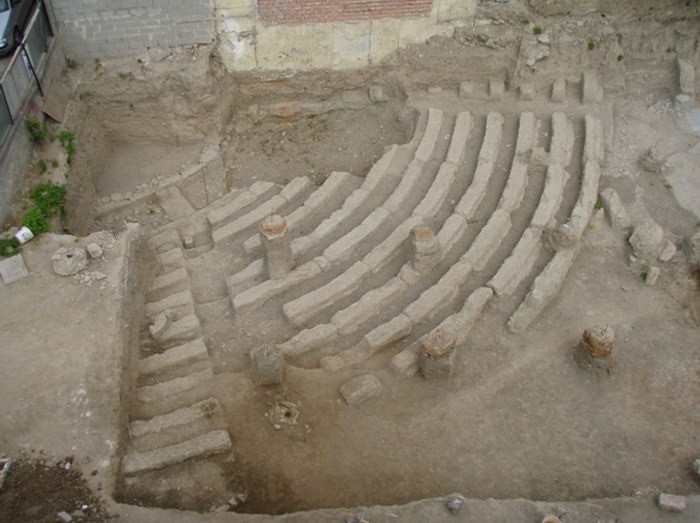Archaeological Collection of Acharnes
Archaeological Collection of Acharnes
The Archaeological Collection of Acharnes has been housed since 2006 at 76 Philadelphias Avenue, opposite the Acharnes Town Hall. The archaeological material exhibited in the Collection comes mainly from Acharnes, but also from neighboring municipalities (Kifissia, Ag. Anargyroi, Metamorfosi). The findings resulted from rescue excavations carried out on private plots and in the context of the construction of large public works (opening of Kymi Avenue to Olympiakos Village, Attiki Odos, Acharnes Railway Center) and chronologically represent all phases of habitation from the late Neolithic period to the Middle Byzantine years (4600 BC – 12th century A.D.).
In the antechamber are exposed a sharp-pointed pithos from Roman times, an epitaphic pessoid stele (4th century BC) that mentions the names of the Acharnian family and a mold of an epitaphic stele – the original is kept in the National Archaeological Museum – with a representation of a hoplite and two women (second half of the 5th century B.C.).
In the main hall, in Showcase I, findings from the late Neolithic to the Sub-Mycenaean period (4600-1050 BC) are exhibited, such as salciera, obsidian blades, etc. Notable Early Bronze Age findings include a fragment of a marble figurine, a written four-leaf vase, as well as fragments of holders and of offering banks.
The next Showcases (II, III and IV) include vases from the Geometric period (9th – 8th century BC) with characteristic shapes and decoration, such as compasses with handles in the shape of horses, etc. Among them stand out a beetle in a representation of a warrior, the horses and a model of a granary.
Showcase V includes vases from the archaic and classical period (7th – 4th centuries B.C.) with characteristic black-figure representations, such as processions of figures (on vases from the Lydos workshop), chariot races and Dionysian scenes.
Showcase VI includes one of the Collection’s most important exhibits, the Florentine painter’s red-figure krater, depicting a javelin winner in the pentathlon, awarded by two Victories (470-460 B.C.).
Showcases VII and VIII exhibit offerings from cemeteries and individual burials from the Late Archaic and Classical periods, such as black lekyths (of the painter of Megaira, the painter of Diosphos, etc.), white lekyths (of the painter of Athens 1826, the painter of Sabouroff et al.), as well as red-faced lekyths (of the painter of Kloegman et al.). Alabaster with traces of gold leaf coating, copper string and copper mirrors stand out. A marble cylindrical case with a copper cauldron, containing the remains of cremation (5th century B.C.) is on display between the galleries VII and VIII.
Showcase IX presents a bath with a child’s burial (5th century B.C.)
Showcases X and XI include findings from excavations dating from the Late Archaic to Roman times (6th century B.C.-4th century A.D .). Notable are the objects from the sanctuaries of Dionysus and Aphrodite and the urn hydria of the Western Slope type with gilded floral decoration on the neck from a private plot. Also of interest are the bronze judicial plaque of Kifisodoros from Acharnes (second half of the 5th century B.C.) and a bronze coin from Byzantine times (12th century A.D.), while,
Showcase XIII hosts excavation collections from classical to Byzantine times, such as lamps, sealed handles of commercial amphorae and a hoard of 14 copper coins (late 6th – early 7th century A.D.). Between the two above showcases are exposed a beehive with a stopper, two marble epitaphic inscribed columns, an inscribed Hermaian stele and a pointed amphora from Roman times. In the continuation of Showcase XIII, stone findings from Archaic-Roman times are presented: parts of epitaphic columns and sculptures, such as the head of a daughter and guard dog, head of a hermaic column, part of an inscription referring to the construction of the Acharnik Aqueduct and terms.
In the middle of the main hall, stone sculptures of the classical-Hellenistic period (5th – 1st century B.C.) are lined up, such as epitaphic columns, lykyths and bathers, a votive inscribed pedestal of a high school leader of the Great Panathenaia, the trunk of Hercules and a porin case with a copper urn cauldron. The epitaph stele of the key priestess Filokiristis (4th century BC) stands out. The Archaeological Collection is interspersed with rich observational material related to the history of Acharnes and the neighboring municipalities of Parnitha, the timeless habitation of Acharnes, as well as the monuments of the area (vaulted tomb, ancient theater, Hadrian’s aqueduct, etc.).








